Ceiling design: subtleties of interior design
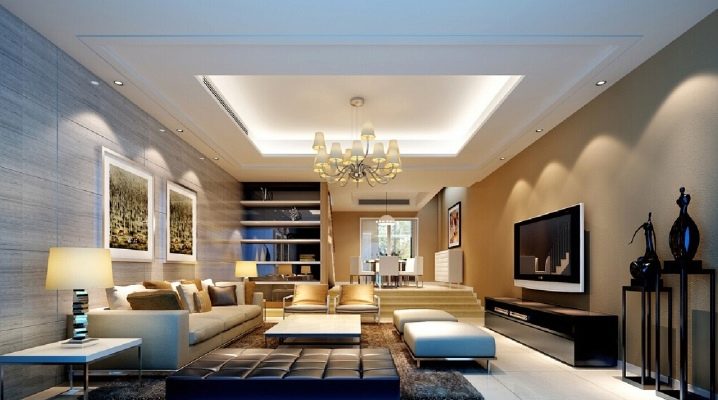
Home ceiling decoration is a key component of the interior of any room. Today, the design of the ceiling area is akin to art: with a careful and creative approach, it allows you to create a unique composition, through which the perception of space changes. Consider the existing design compositions.
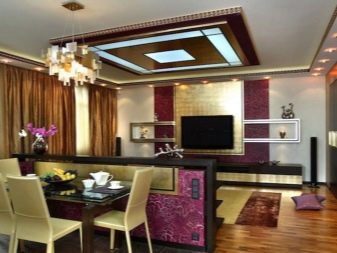
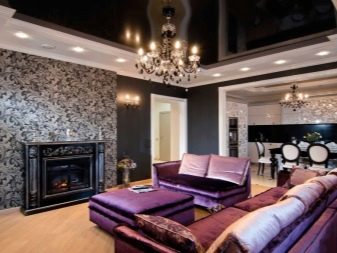
Peculiarities
The design of ceilings in an apartment or a private house is subject to the characteristics of a particular room. In this case, any little things matter, starting from the area and ending with the width of the molding. Initially, a visual inspection of the entire room is carried out, taking into account its purpose. After that, a project is drawn up, which should take into account a number of nuances:
- The shape of the ceiling will depend on the purpose of the room. For example, for a kitchen it can be simpler; for a living room, the design can be complex with several accents.
- Color matters. It is selected based on the degree of illumination of a particular room. At the same time, we must not forget about the style chosen for the interior: it is important to maintain a balance of color, choosing in each case exactly the range that is characteristic of a certain direction. In this case, the shade of the ceiling material should soften the interior composition.
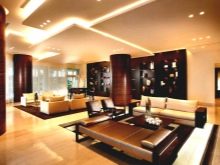
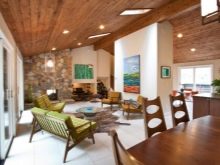

A complex design should not draw attention to itself. If bright colors are used in large quantities in the decoration of the ceiling area, this will violate the harmony of the situation, the atmosphere in the room will lose the feeling of home comfort.
- Often, the broken perspective of the room can become a limitation of the design. This aspect will lead to an increase in the cost of coverage. However, this also has an advantage: you can visually divide the space into separate areas, for example, through different levels. This will create an unobtrusive organization in the room, at the same time changing the perception of the flaw in the ceiling design.
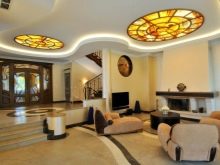


- As for the footage of the room, everything is simple here: the smaller the room, the simpler the design. In this case, the size of the decor is also important. For example, you cannot use wide moldings or moldings for framing in a small room with a low ceiling. It is also unacceptable to use miniature decorative elements in a spacious hall or an open-plan apartment.
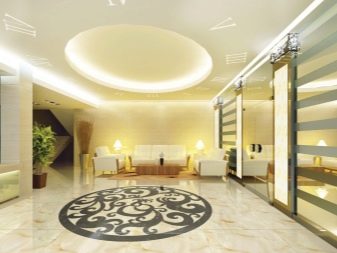
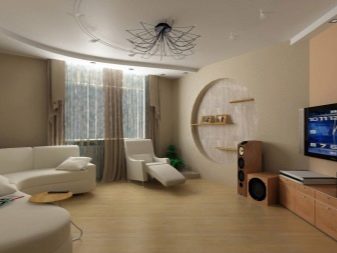
- The design is selected in such a way that it has sufficient lighting, made with a special approach. Today, lighting can make any ceiling design unique. If you approach the decoration creatively, choose the right shade, pattern, its size, as well as lighting, you can erase the boundaries of the ceiling, fill the space with light close to natural, create a special atmosphere of mystery and even feel the proximity of space.
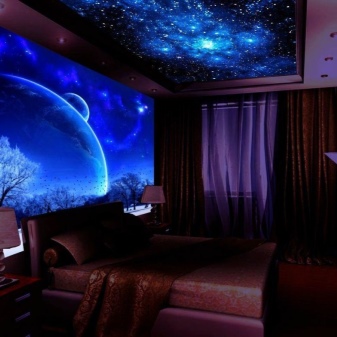

The design plan implies the creation of a structure, taking into account the required lighting, which in some cases is combined, combining built-in and surface-mounted types of lamps, LED strip lighting. Sometimes, when creating a structure, the ceiling material is specially pierced in order to conduct fiber-optic threads for special illumination. The type of ceiling also matters.In some cases, it provides for the preparation of the coating with leveling it to perfection, in others it is not at all necessary to prepare the base: the material is fixed on the frame.
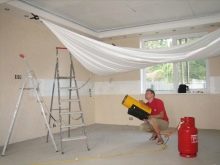
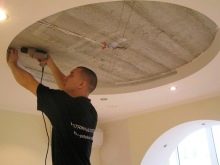
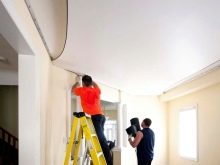
Single-level and multi-level structures
The decoration of the ceiling has become possible thanks to the development of building technologies and the use of various materials. Depending on the type of material used and the wishes of the customer, the ceiling design can be single-level, two-level and multi-level. Today, all designs can be divided into several types:
- suspended;
- tension;
- rack;
- cassette;
- hemmed;
- adhesive.
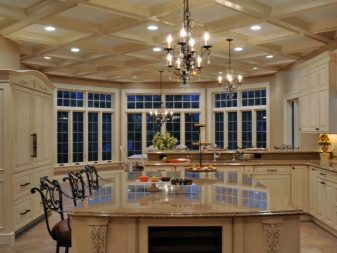
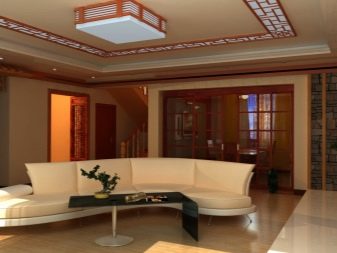
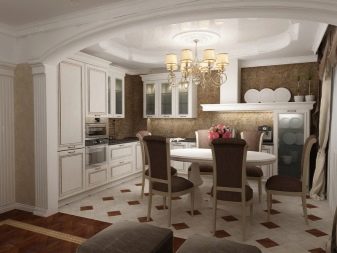

Of these categories, rack and cassette varieties are the least in demand. They look beautiful in public places, the combination of slats with mirror inserts creates a special atmosphere, but this design cannot be called appropriate for a home. This finish visually divides the space, reducing its volume. In addition, it has low thermal insulation, although these materials are resistant to moisture.

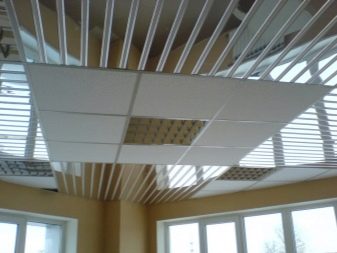

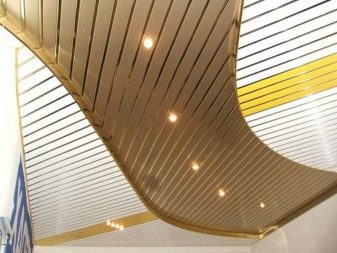
Glue ceilings, despite their apparent simplicity, are in great demand. Today it is not just PVC tiles: there are so many materials that, if you wish, you can create a unique design that fully meets modern standards of creativity and originality. This is especially true for fragments of wood and metal of an unusual shape, connected by means of a seamless technology. They look good in the interior of an apartment and a private house.
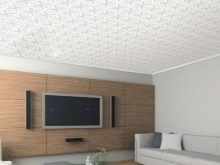
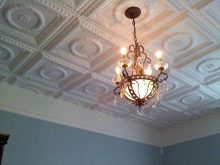
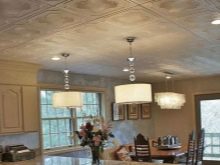
Sewing varieties are performed mainly from lining or boards. Sometimes a laminate is used in the decoration, if you need to make a partial accent of the wall with a transition to the ceiling.
This design is more often inherent in private and country houses. It is far from understanding the classical direction, rather it is suitable for interiors in an ecological style or an alpine chalet.
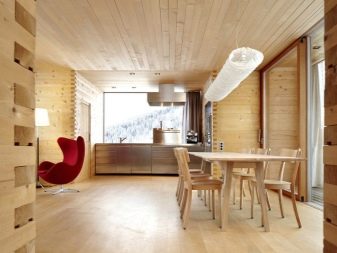
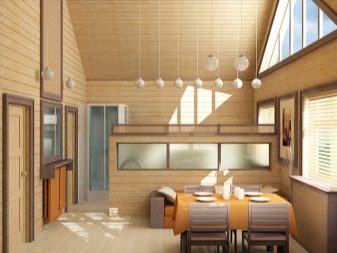
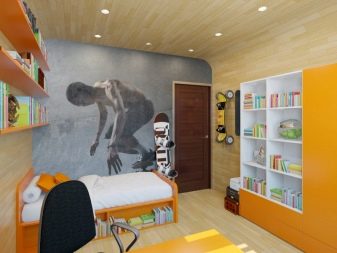
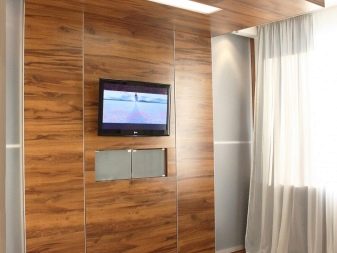
The most popular types are stretch and plasterboard ceiling structures. They can have 1, 2 or more levels, differ in the complexity of shapes and lines. Both varieties are notable for ease of installation, the absence of the need to level the base. If you wish, you can arrange the ceiling in both versions on your own, without the involvement of outside experts. Let's consider their differences.
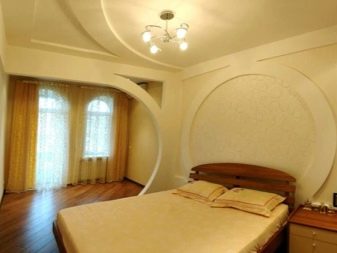
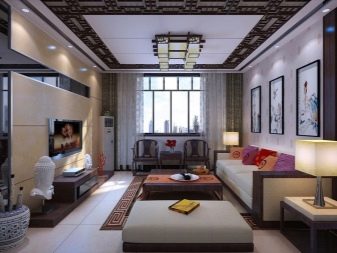


Plasterboard
A plasterboard ceiling is a structure installed on a frame made of ceiling profiles. Plasterboard sheets are attached to profiles, creating a ceiling from levels of different shapes, or a symmetrical composition. The complexity can be any: drywall bends perfectly, which allows you to give the ceiling design a lot of curly lines. The use of two contrasting shades in the design looks unique: this allows you to enhance the effect of different levels.
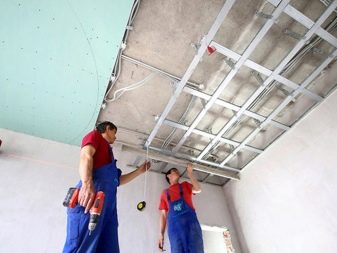
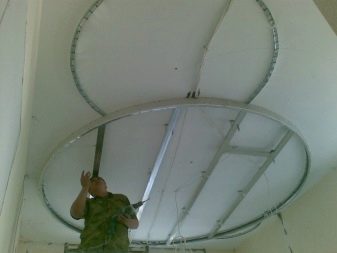
Despite the fact that this material is especially popular, more often in the design of the ceiling it is supplemented with a stretch film or satin. At the same time, for modern interiors, they try to focus on a glossy texture. For vintage or classic directions, a matte finish is selected. A distinctive feature of drywall is the ability to paint and resistance to moisture, which allows it to be used in any room of the home (up to the bathroom).
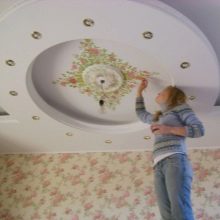
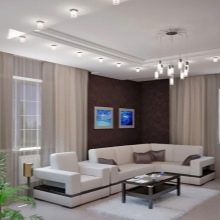
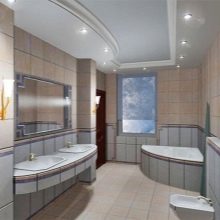
Tension
These structures are made of film and textiles, which are stretched over a special frame. The surface of the material can be matte, glossy and satin (with a characteristic silk finish). Glossy ceilings bring volume into the space, they visually enlarge the room, however, the mirror effect contributes to the reflection of all objects on the ceiling, which makes it difficult to decorate this canvas with photo printing.

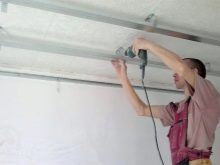
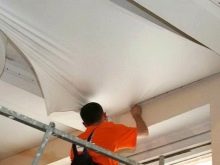
The image on a matte or satin surface looks expressive.The most expensive material for a stretch ceiling is satin, so it is often combined with a film, which allows you to create a unique effect.
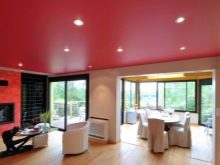
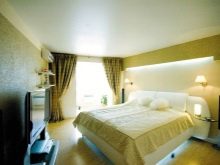
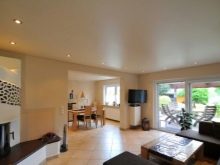
Finishing methods
Today there are many ways to decorate the ceiling. Let's look at the basic decoration methods.
Ceiling tiles
This material is presented in a wide range today. It includes tiles made of foam, wood, plastic and metal. The most budgetary option is considered to be porous, extruded and injection tiles in the form of squares made of expanded polystyrene. Each variety has its own manufacturing technology, which affects the cost and thickness, as well as design (some categories perfectly imitate the texture of wood, marble and stone). This tile can be regular or seamless, with straight and curly wavy edges.

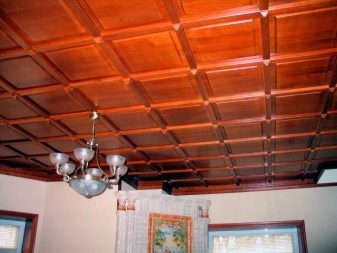
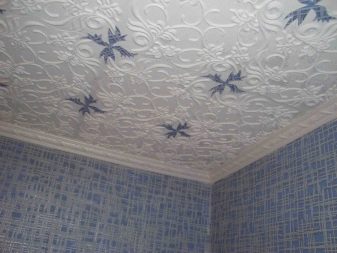
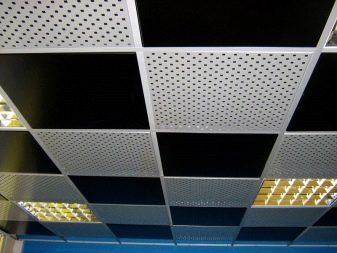
Wooden tiles are characterized by simple channel patterns that create geometric shapes. Varieties can be square or rectangular. Metal and plastic options can have mirror inserts. The former have a characteristic metallic sheen and a rich color palette. The latter are used less often for finishing the ceiling, but they are lighter than metal counterparts.
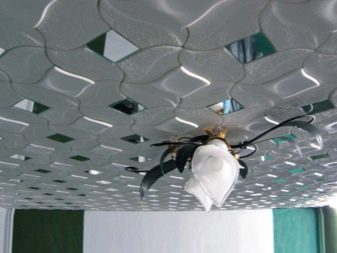
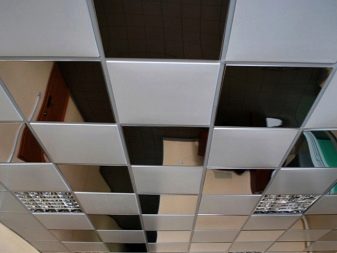
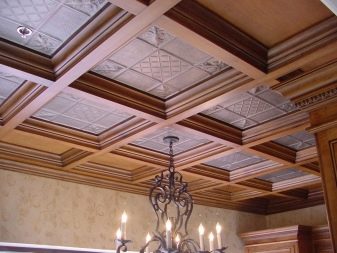
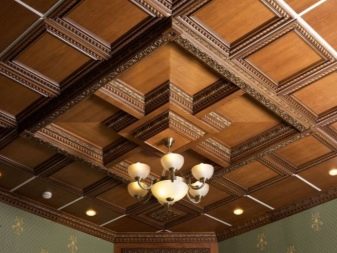
Skirting board
The finishing elements of the ceiling design in most cases are a variety of cornices, moldings and polyurethane ceiling plinths. Today, on the market of finishing materials, this finish is presented in a wide range for every taste and budget. At the same time, you can choose a model not only in color to match the finishing of the overall interior of the room. Models provide a variety of patterns, including imitation plaster moldings, widths, and various fastening methods.
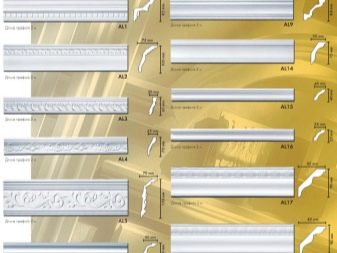
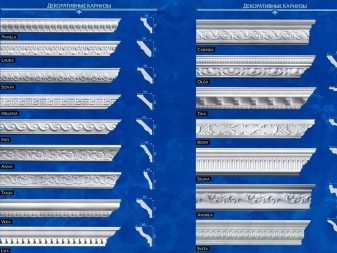
In one case, the glue method is used to fix the decor to the ceiling, less often it is attached to special brackets. The advantage of such a decoration element is the ease of installation: in most cases, you can decorate the ceiling with this decoration with your own hands. It does not take much time, and the design of the ceiling zone can be done after the installation of the main structure, leaving a gap for masking lighting devices.

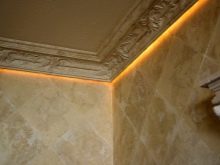
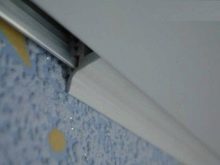
Beams and communication systems
This decoration in the design of the ceiling is used for creative stylization for an industrial facility. Today, this option is more in demand than ceiling tiles, stretch ceilings with photo printing and multi-level plasterboard structures. For the entourage, you can buy false beams: they look realistic. A mandatory attribute of this design is the presence of pipes and wiring.
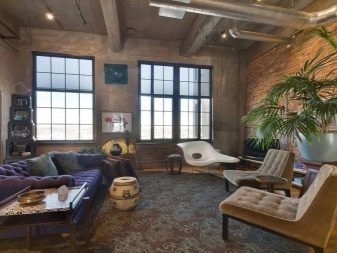
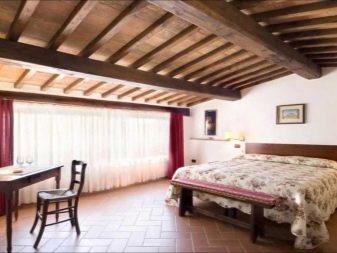

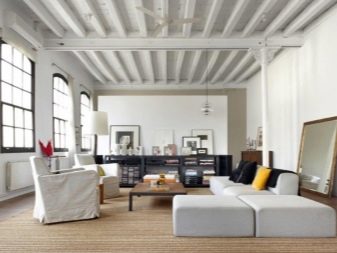
In addition, it is important to demonstrate the correct lighting. It can be a bundle of LEDs on a tube or point spots with a tilt adjustment system. The rougher the lighting fixture, the better. Simple bulbs on a metal frame without a plafond are welcome, while the degree of illumination should be close to natural light.
An important nuance is the use of modern lamp models in the design of the ceiling: the priority is LED light sources of linear, point and ribbon shapes.
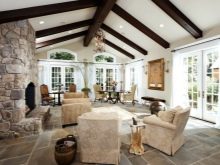
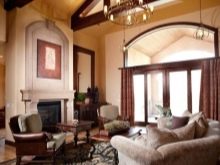

Window
This finish is relevant for the attic floor ceiling, which is especially popular in the interior of private or country houses. In such structures, windows are often located on the slope itself, which is the roof. Window openings are limited in size. An interesting solution when decorating an attic for a nursery is the use of translucent curtains on the windows, which are fixed on both sides so that the textiles look beautiful. Sometimes the highlight of such a ceiling, in addition to beams, can be lamps in the form of panels or a window opening in the form of a hatch.
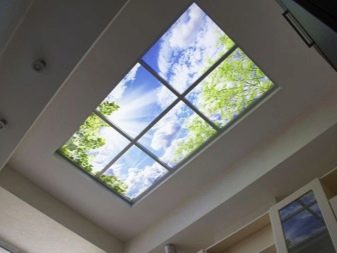
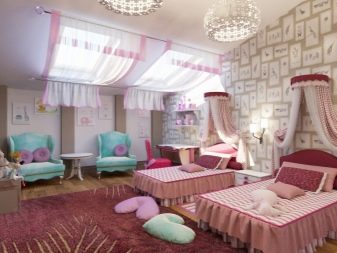
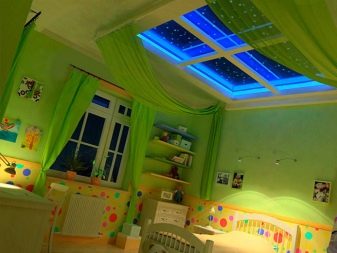
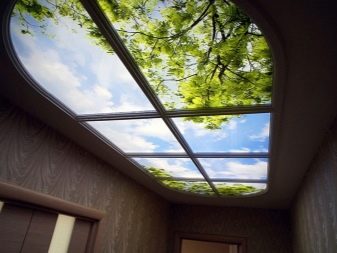
Photo printing
This decor is used using stretch structures made of film or textiles, including satin.The theme of the image depends on the wishes of the customer and the purpose of the room, the size of the print is subject to the footage of the room. Photo printing is applied to the canvas using a special technology, due to which the image is distinguished by the expressiveness of lines and the accuracy of the reproduction of shades. With a good choice of pattern, you can add a special mood to the atmosphere, give the space depth and a sense of home comfort.
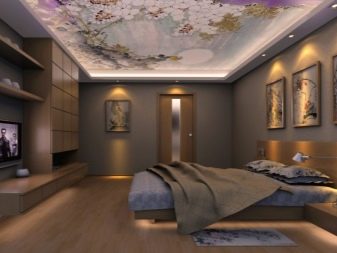
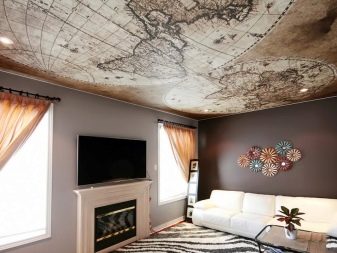
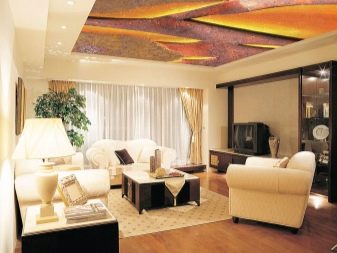
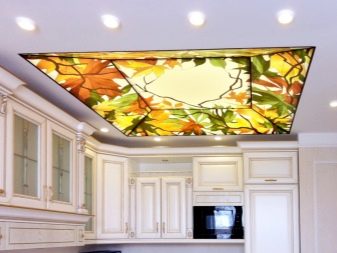
Most often, the themes of the drawings are floral motifs, images of the sky with clouds and stars, portraits of ancient gods, angels and doves. However, not every drawing can be called successful. For example, large prints on the ceilings of small rooms and bedrooms visually reduce the space and create an oppressive atmosphere. A simple ornament looks much more interesting on a stretch ceiling, passing to the wall. If at the same time only part of the wall is involved, such decor looks stylish and zones the space of the room.
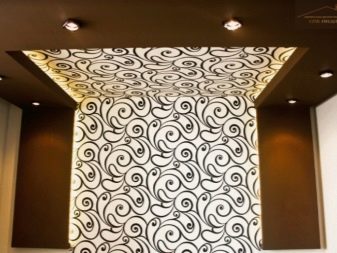
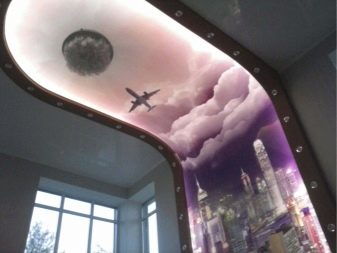
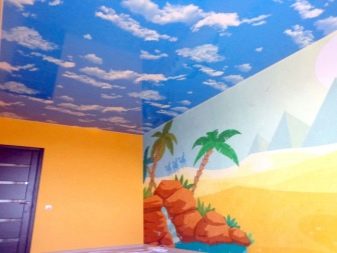

Painting
This decor belongs to the category of especially relevant if it is performed by a professional with artistic painting skills. The theme of the image depends on the purpose of a particular room. More often, such a ceiling design is performed starting from the wall, moving to the ceiling. For example, in the bedroom, these can be branches coming from a tree located on one of the walls, as well as sakura petals, delicate curls or flowers, shoots or leaves of exotic plants.
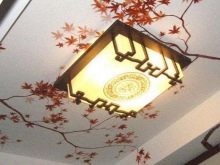
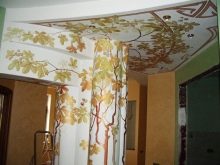
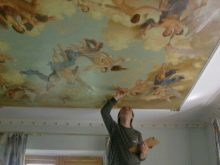
In the nursery, on the ceiling, you can depict a picture of a summer morning, the sun surrounded by clouds and birds. With the right choice of additions, you can combine painting with decorative stickers.
For example, the same tree, whose branches extend to the ceiling, as well as flowers or openwork lace, can be decorated with 3D butterfly stickers, arranged in a chaotic manner. This finishing technique provides for the inclusion of sparkling crystals in the decor or the highlighting of elements by means of light, which gives the ornament a completely different perception.
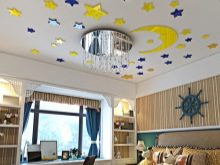
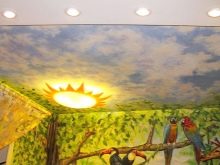
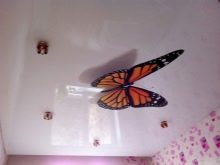
Combination
This technique is one of the most popular in ceiling decoration. It allows you to beat the flaws of the base, using different materials to decorate different places. For example, a stretch canvas can be placed only in the center of the room or in a certain part of it based on the characteristics of the furniture. If this is a living room combined with a dining area located in a bay window, a stretch canvas can decorate the main part of the ceiling. For a bay window, you can make a separate box and accentuate the ceiling with separate lighting.

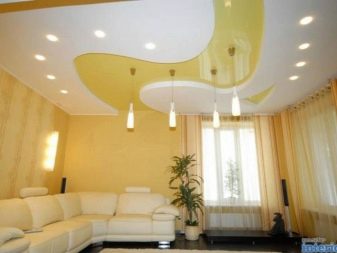
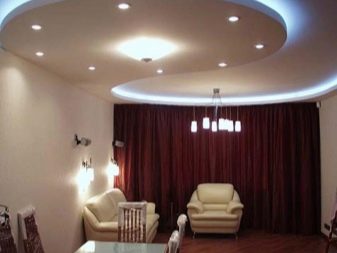
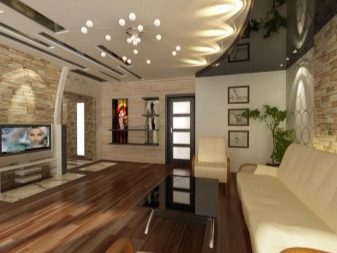
It looks interesting to play around the design features of the ceiling with the help of wood or metal ceiling tiles. In addition to the fact that it can be glued in the central part of the ceiling and decorated around the perimeter with a molding to match or contrast with the main ceiling plinth, such material is also useful for framing other finishes. For example, wooden tiles look beautiful over the place of the dining area, performing an unobtrusive organization of the kitchen. With a successful selection of elements, you can combine photo printing, tiles and molding, you can select ring shapes for the chandelier to decorate them with lighting.

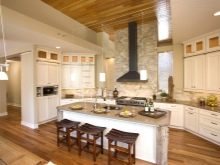
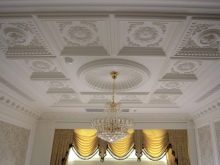
Foam tile materials are successfully combined with gypsum stucco molding. The stucco ceiling is harmonious in classic design directions. Wooden structures need contrast, this makes the surfaces expressive. For example, wood harmonizes with metal in a creative way.
If the wood is painted with light paint, then it looks better with plastic. A metal-based tile covering with mirror inserts can be complemented by a very beautiful lamp, complex combination is inappropriate here.
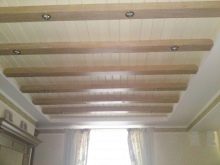
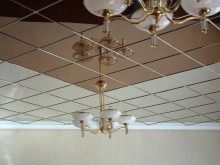
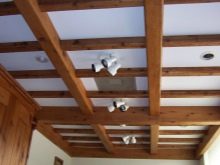
Color matching
The color scheme of the ceiling depends on the purpose of the room, its footage and the degree of lighting. All criteria are subject to general design ideas.The goal of every design idea is to add space to the room. Therefore, the priority is white and light pastel shades.
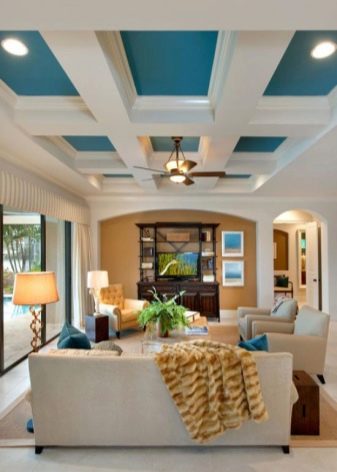
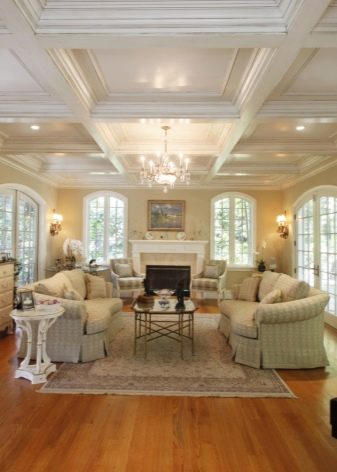
The current colors of the ceiling area are blue, bleached blue, light beige, milky, light cream and white-gray. If the space is spacious, there are more saturated colors in the ceiling decoration. For example, it can be lilac, gold, silver, sand, yellowish paints. However, designers note that when designing a design, it is necessary to add white to any contrast, which can soften the bright tone and fill the interior with light spots.
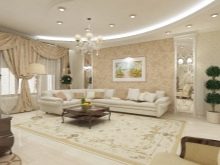
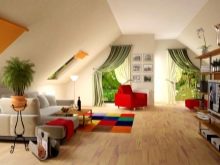
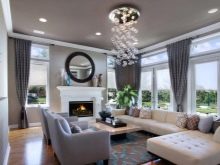
The most interesting combinations of shades in the design of the ceiling today are:
- coffee with milk + light beige;
- wood + metallic;
- white + milky, olive, steel blue, beige, gray, woody.



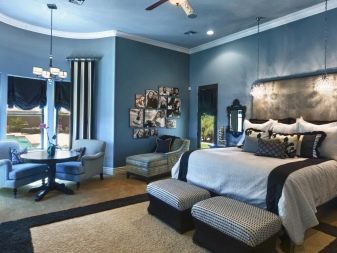
In addition to bright contrasts, some designers use a single white color, decorating the ceiling with multi-colored LED lighting, changing its shade at will. Dark contrasts for the ceiling are unacceptable: they visually set a rigid frame, which deprives the space of comfort.
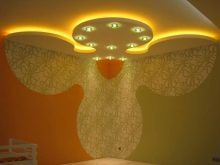
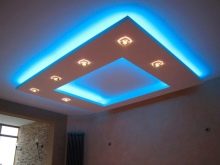
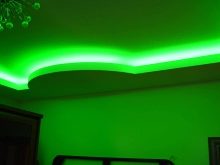
Lighting
Today, it is lighting that can make the ceiling special. Even the most beautiful and stylish design looks lonely without the right light composition. However, not everything is so simple: today it is customary to perform illumination in a special way, combining several types of lamps in the design of the ceiling. Consider their main varieties, through which you can decorate the ceiling area. They are classified according to the type of attachment and type of lamps.
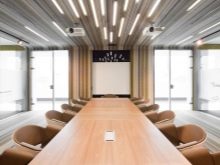
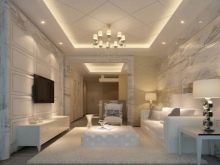
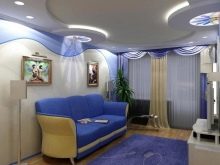
In the design of the ceiling, central lamps and auxiliary lighting are used.
Central lighting
Pendant and surface type chandeliers are included in this category. In fact, the former are models on suspensions in the form of a thick and durable cord or chain. These structures, as a rule, are heavy and have placement restrictions. They cannot be installed in rooms with low ceilings. They are appropriate in the living room, study, home library, while it is important that the room is spacious.
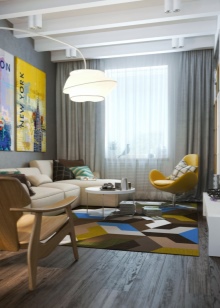
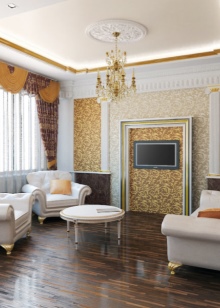
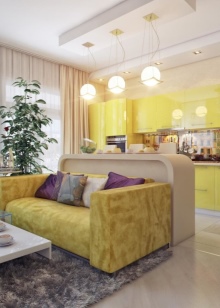
Near-surface central lighting fixtures are nothing more than ordinary compact chandeliers that are mounted close to the ceiling. They can be different, but more often these are models with a characteristically flattened shape. The advantage of luminaires is that with their help you can visually beat the lack of ceiling height, and give the space of a particular room a sufficient level of illumination. Some varieties are volumetric panels with powerful lamps that gently scatter light through a closed top layer to all corners of the room.
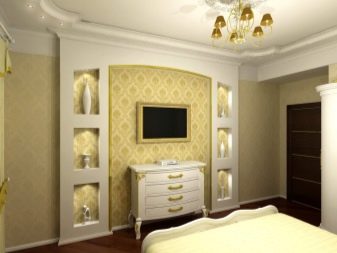
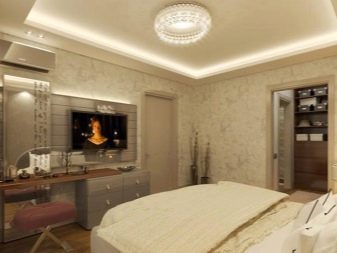
Backlight
This type of lighting is the main focus in ceiling design today. The backlight often functions as a central lighting. With its help, you can give the space a clear organization, accentuate the desired area, using lamps of different design and shape for the composition. This technique is especially appropriate in the design of an open-plan ceiling. At the same time, for each individual functional area, you can choose your own type of decoration, through which you can not only illuminate the space, but also delimit it.
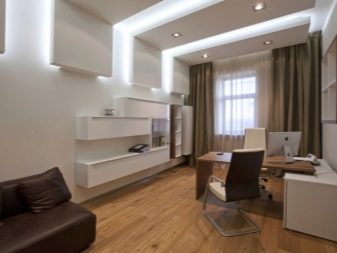
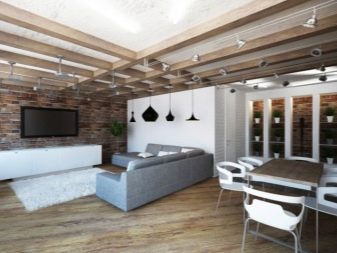
Conventionally, this lighting for the ceiling can be divided into several types. All of them are based on LED light sources, which are economical and harmless today. During operation, they do not emit toxins into the air, do not flicker or buzz. Diodes convert most of the energy consumed into light, so they do not melt the ceiling material if they are embedded inside the structure.
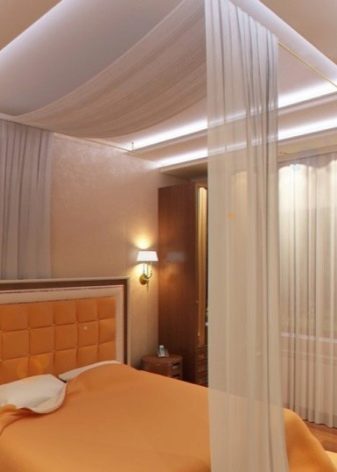

Depending on the conceived design of the ceiling, spotlights, adjustable spots and flexible tape are used in the design.The former often frame the box at regular intervals, the latter are appropriate in a creative style (they are attached to the beams). The tape is remarkable in that it is able to exactly repeat the figured contour of any ceiling structure, it can be built-in or hidden between the molding and the edge of the wall.

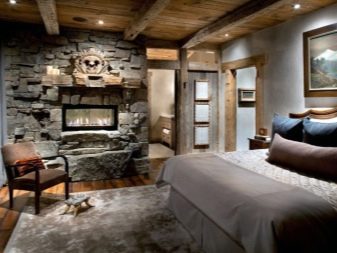
In addition, fiber optic filaments are used to create a unique realistic design, which are embedded in structures for the effect of twinkling stars.
Most often they are combined with a diode strip, embedding in the construction of an RGB type model with a change in the color shades of the luminous flux from neutral white to violet, including blue, pink, orange and many other tones.

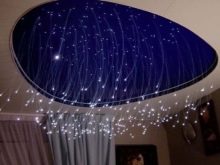
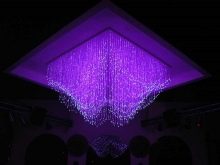
How to choose for different rooms?
The design of the ceiling is individual in each case. Consider several options for decorating the ceiling space based on the main features of the room.
- Living room. For a given room, the only limitation may be the lack of space. This room is the hallmark of any home, so it is in it that you can show great imagination, using a combination of different materials. Curly and asymmetrical lines, complex multi-level ceiling designs, decorated along the contour of different levels with separate lighting, look beautiful in the living room. Here, models of two shades are appropriate, which can be made to match the furniture, as well as options with a metallic sheen.
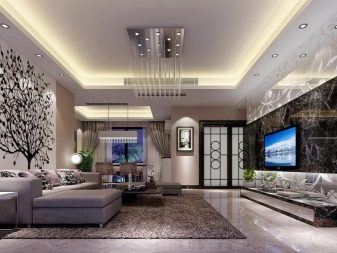
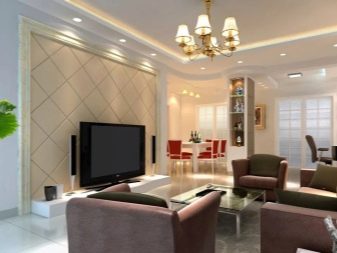
- Bedroom. Here, the atmosphere should be inviting, so it is important to provide your eyes with maximum rest: bright lamps and powerful chandeliers in the design of the ceiling are excluded. A matte surface texture and simple forms of construction are preferred. Often, LED lighting around the perimeter of the ceiling is sufficient to maintain an atmosphere of home comfort and relaxation.

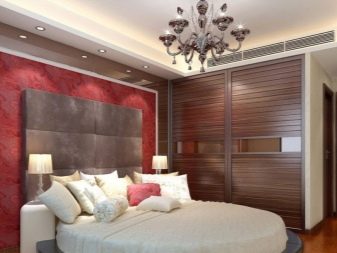
- Kitchen. For this room, the main factor is the features of the walls. If the space resembles a square, they try to draw it out with a decorative rectangular insert of drywall or a stretch canvas with a frame. The structure with a stretch canvas and drywall looks interesting, through which the hood with illumination passes. At the same time, it is not necessary to use a drawing in the decoration: for a complex decor, spot illumination is sufficient.
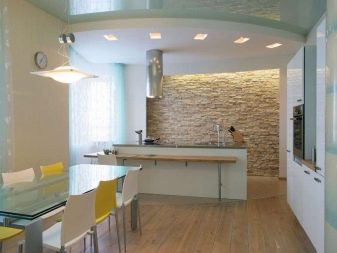

- Corridor and hallway. It all depends on the layout. If the walls are sloping, they try to decorate the ceiling of the hall with the reception of asymmetric lines, diverting attention from the curvature of the walls, which visually create an internal imbalance in the entrance room. Using a curly line, you can create the illusion of spaciousness. For a narrow corridor, typical of a small "Khrushchev", it is better to use a simple plasterboard box: the tension structure is inappropriate here. Square tiles (even from expensive materials) do not always look here either: geometric elements visually crush the limited space.
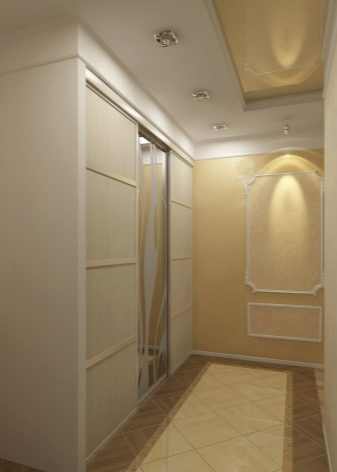
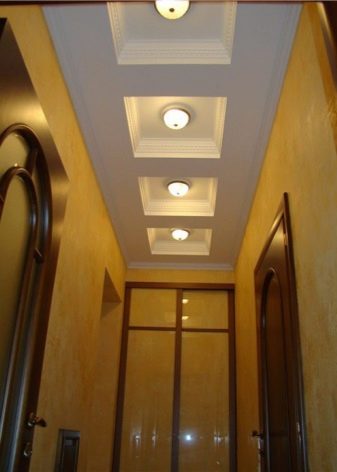
- Studio. In this case, it is important to maintain a balance: since, due to the open planning, all functional areas are in sight, the ceiling should not be multi-level. At the same time, light projections are allowed for two zones of the space (as a rule, guest and dining). Sometimes the ceiling is designed in such a way that the curly line starts from the dining area and smoothly passes into the guest area. Modern layouts allow a lot of design possibilities.

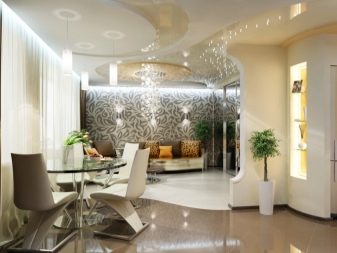
To make the ceiling not only beautiful, but also appropriate in a given space, it is necessary to draw up a design project at the initial stage of the renovation. This will avoid the feeling of pressure on the walls, because complex structures often reduce the height of the ceiling. With a skillful and modern approach to decoration, you can make a stylish solution with zoning, hide uneven ceiling defects, and visually get rid of low walls.
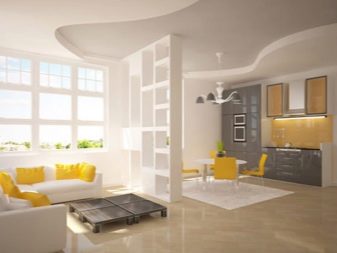
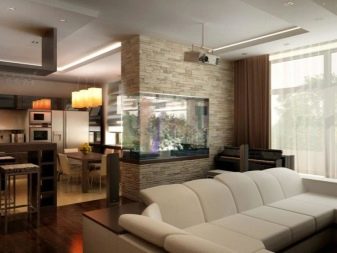
- Bathroom... In this space, they try to fulfill the classic design of the ceiling to match the main decoration, since the tiles that decorate the surfaces of the walls and floors are a durable coating. For decoration, they try to choose the appropriate options, decorating the surface of the base with ergonomic lighting. In the decoration, you can use new materials that are resistant to the negative effects of moisture. Foam tiles are unacceptable here, but drywall is suitable.
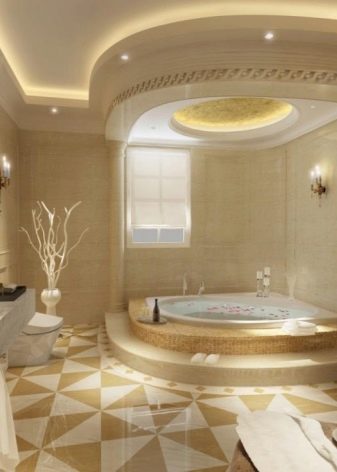
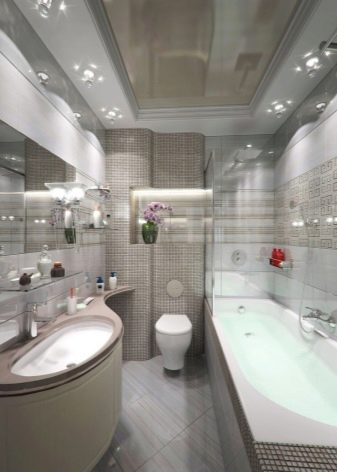
Beautiful examples in the interior
To appreciate the versatility of the design idea in the design of the ceiling of the home, let us turn to the examples of the photo gallery. Among the mass of possibilities, everyone will find for themselves the most interesting ideas and options for decorating the ceiling.
The most beautiful example of the design of the living room of a country house, which has wide windows and doors on adjacent walls. In the design of the high ceiling-roof, the key elements are windows, beams and stylish chandeliers with suspensions. Upholstered furniture near the fireplace and carpeted flooring create a home atmosphere.
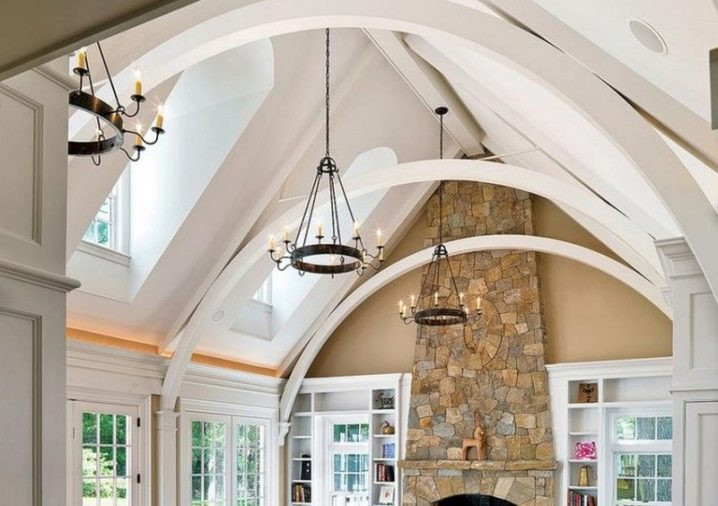
Accentuating the sleeping area with a complex asymmetrical design looks stylish and modern. The material is used in the decoration to match the shade of the door and the bed itself. Highlighting each contrasting detail creates a three-dimensional effect.
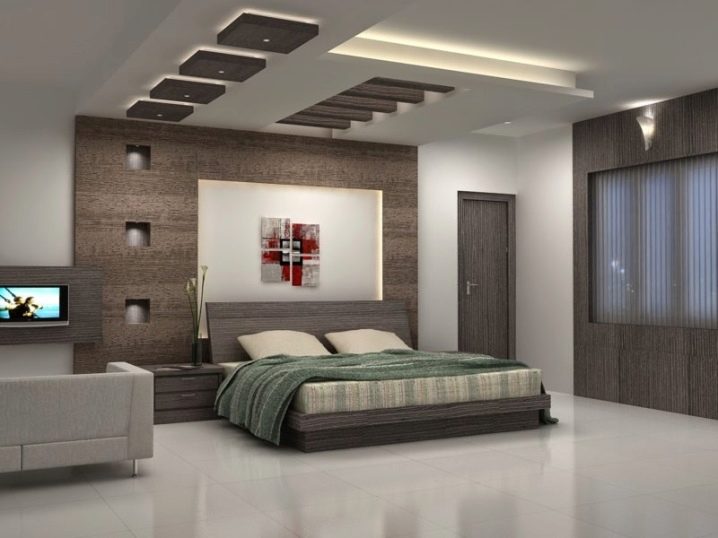
The combination of mirror tiles with drywall allows you to accentuate the guest area, due to the luxurious chandelier and lighting around the perimeter of the two-level structure, the space is filled with light.
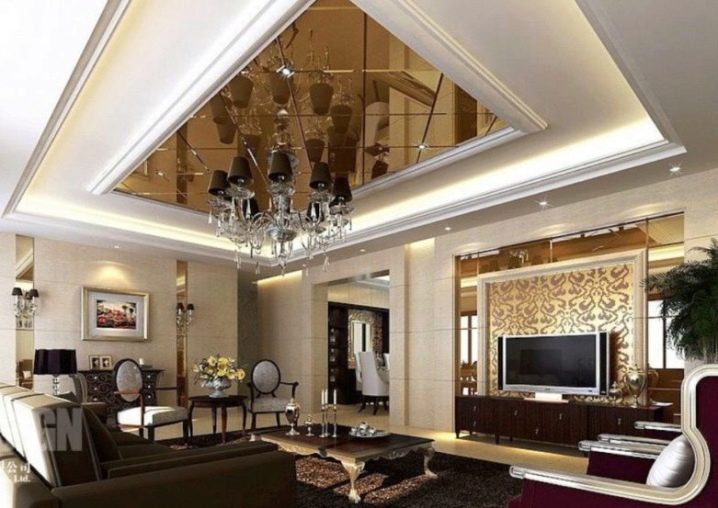
The combination of drywall and wallpaper allows you to highlight the sleeping area at the headboard. Accentuating the ceiling ledge with spotlights along the level contour ensures the proper level of light, the strip lighting enhances the multilevel ceiling.
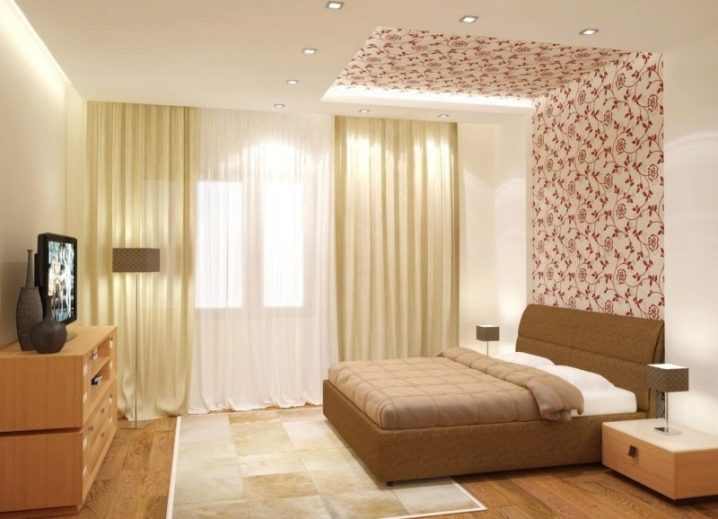
Allocation of the cooking area with a separate plasterboard two-level structure with compact pendant lamps of a laconic shape creates a unique atmosphere. Using the built-in backlight compensates for the lack of light.

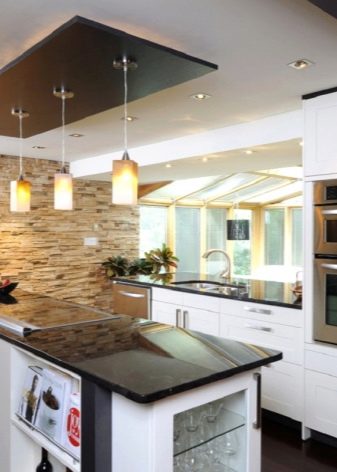
For designer tips on decorating ceilings, see the following video.













The comment was sent successfully.